How to properly plant garlic before winter?
Did you listen to your grandmother, who insisted that garlic helps against all diseases? Modern research confirms this: spicy cloves, consumed regularly, significantly reduce the incidence of acute respiratory infections and acute respiratory viral infections, help preserve youth, and so on.
It's time to grow your own winter garlic. Why winter? It ripens much faster than the spring variety, its cloves and heads are larger, and it often has superior taste. Check out our article, where we will talk in detail about the intricacies of planting garlic in the fall before winter. Grandma approves.
After what crops is garlic planted?
Gardeners have long noticed that vegetable crops grow poorly if they are planted in one place every season. Plants select the same minerals from the soil that they need to grow.
The rules of crop rotation help to avoid such negative aspects - not only to grow a rich harvest, but also to improve the health and saturate the soil with useful substances.
Optimal precursors for garlic
Cereals are considered the best predecessors of garlic. These plants are also called green manure; they improve the chemical composition of the soil and have a positive effect on its fertility.
Their leaves and stems are excellent organic fertilizer. The roots loosen and bind the soil, where moisture and oxygen penetrate better. The exception to the rule is barley and oats, after which garlic cannot be planted.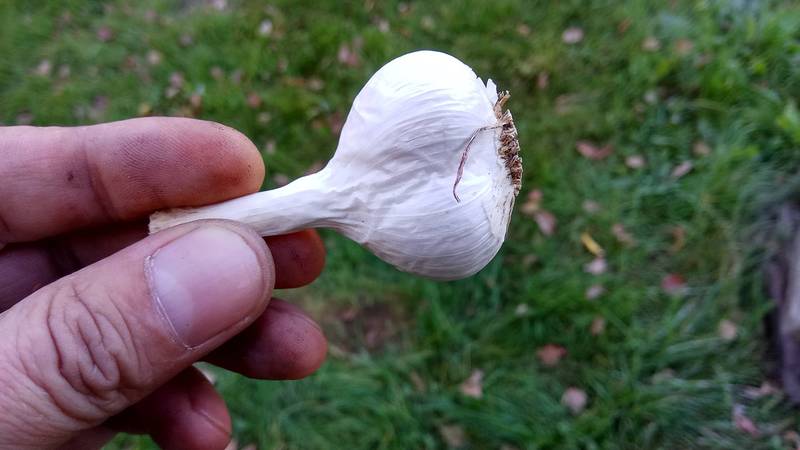
Garlic crop rotation rules
Then the garlic is planted:
- mustard;
- cereals;
- zucchini;
- cucumbers;
- squash;
- cabbage;
- berry bushes.
By the way! If there is not enough space on the plot, you can plant garlic between the strawberry rows. This will not harm the plants, they get along well side by side, and both crops will have enough nutrition in the soil.
What are they planting? after garlic:
- greens (parsley, dill);
- salads;
- early potatoes;
- in warm regions (otherwise they do not have time to ripen) beans or early ripe cucumbers.
Important! Gardeners also use this method. After harvesting the garlic, mustard, buckwheat, alfalfa, peas, and any green manure are sown in its place. The grass must be mowed before flowering; the cuttings are left on the beds, which are dug up before winter. The soil becomes more fertile.
How to choose planting material
When deciding on a variety, it is necessary to take into account the climate zone and follow several simple rules for selecting suitable seeds.
Seed selection rules
High-quality planting material is the key to a good harvest. We select seeds according to the following criteria:
- cloves for planting should be taken from heads that are well ripened and dry for storage;
- all the teeth must be healthy, even slight rot or mold on one of them indicates a problem; seeds from such a bulb are not suitable.
Seeds from degenerating garlic will also not produce a full harvest. The following signs indicate degeneration:
- there are few cloves in the onion and they are large in size;
- the size of the teeth varies significantly;
- the teeth are fused together or have two tips.
Preferences when choosing a variety
Garlic that suits your climate zone grows best. Therefore, prepare the seeds yourself or buy them at a local store: the optimal planting material is grown within a radius of one hundred kilometers from your garden plot.
Purple striped varieties are preferred.They are less whimsical and tolerate low temperatures better. You can plant several varieties on the site and determine which one suits best.
Interesting! Large farms prefer spring garlic to winter garlic. The fact is that the lion's share of varieties for planting in winter is creeping garlic. In a small garden it is easy to get rid of shoots, but in a large plantation it is expensive to remove them.
Popular varieties of garlic
Let's look at the main characteristics of commonly found varieties of garlic. It should be remembered that the timing of autumn planting depends on the specific region.
| Name | Ripening time | Days until cleaning | Head weight | Disembarkation time | Productivity
|
Peculiarities |
| Titanium | Mid-late
|
100-115 | Up to 150 g | September-November | Up to 1.9 kg/m² | Large-fruited, shoots, the color of the husk is violet-lilac, the taste is sharp, the keeping quality is good. |
| Lyubasha | Mid-season | 90-100 | Up to 150 g | Late October-mid November | 1.5-2 kg/m²
15-20 t/ha |
Large-fruited, bolting, frost-resistant, white-pink husk color, spicy taste, good keeping quality. |
| Dobrynya | Late ripening | 120-130 | Up to 60 g | Mid-September-November
|
2-2.5 kg/m² | Large-fruited, bolting, frost-resistant (but less than “Lyubasha”), the color of the husk is white-gray-pink, the taste is medium pungent, the shelf life is average (up to 20% is lost by the end of the shelf life) |
| Alcor | Mid-season | 87-98 | Up to 40 g | End of october | 0.3-0.4 kg/m² | Shooting, frost-resistant, pink husk color with purple stripes, medium sharpness, good keeping quality. |
| Belorussian | Early ripening | 87-98 | 56-78 g | Second half of September – end of October | 1.2 kg/m² | Shooting, frost-resistant, white-violet husk color, pungent taste, |
How to prepare the soil for planting garlic before winter
The planting scheme for winter garlic begins with choosing a location.This should be a dry, well-lit area where there is no snow.
Once the location has been decided, you need to apply fertilizer and dig up. For good growth and development, this bulbous plant requires nitrogen, phosphorus and potassium. To provide the soil with the necessary microelements, we apply fertilizers.
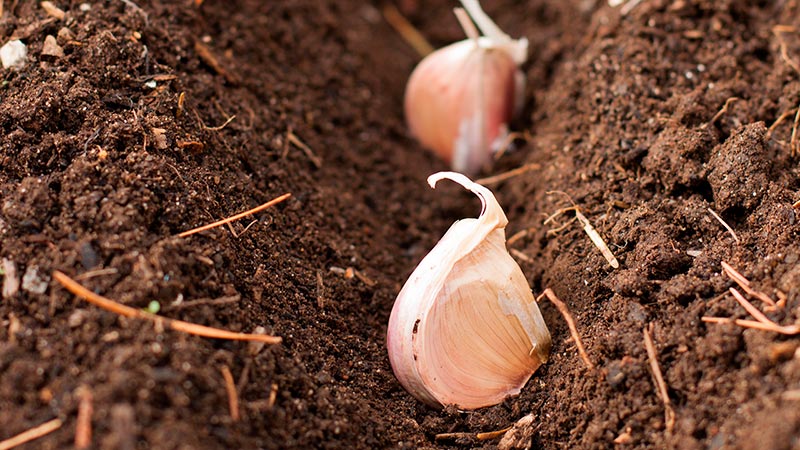 You should not plant garlic immediately after fertilizing and digging. The soil will be loose and after a couple of rains it will settle, pulling the planted cloves deeper. This will certainly have an impact on productivity, because garlic will have to fight its way to the sun longer.
You should not plant garlic immediately after fertilizing and digging. The soil will be loose and after a couple of rains it will settle, pulling the planted cloves deeper. This will certainly have an impact on productivity, because garlic will have to fight its way to the sun longer.
Fertilize the beds
In August-September, garlic beds are prepared. The best way to improve the soil is as follows:
- a square meter of sandy soil needs a bucket of peat, two buckets of clay soil;
- for 1 m² of clay soil you will need a bucket of loamy soil and sand;
- A bucket of peat and sand is added per 1 m² of clay soil.
To enrich any type of soil with minerals, organic compounds are used. The following substances are added per square meter:
- wood ash – 2 tablespoons;
- chalk - 1 glass;
- humus – 10 kg;
- superphosphate – 1 tablespoon;
- Potassium sulfate – 1 tablespoon.
We distribute all this evenly on the site, dig it onto the bayonet of a shovel and leave it for a while so that the ground settles. If there is little or no precipitation, you need to water the prepared area yourself.
Experienced gardeners advise doing one more thing before planting. It will protect plants from damage by fungal diseases. The antifungal agent is prepared as follows:
- copper sulfate - 1 tablespoon;
- hot water – 2 l;
- cold water - 1 bucket.
Vitriol is dissolved in hot water, then diluted with cold water.This mixture is used to water the garden bed; usually it is enough for 2 square meters. m. After the procedure, the bed is covered with film until the garlic is planted.
Read also:
Onion garlic or hair onion - what is Rocambole garlic?
How to preserve garlic for the winter in a tasty and simple way?
How and when to plant winter garlic
Let's figure out how to properly plant garlic in winter. The culture feels great on a ridge a meter wide and 20-25 centimeters high.
After the ridges have settled, you can proceed directly to planting. It is recommended to scatter urea 10-20 g/m² over the area and spill water on the ground.
Beginners ask: “When to plant garlic before winter?” Planting time depends on the weather conditions in your region. Optimally - a month and a half before the first frost.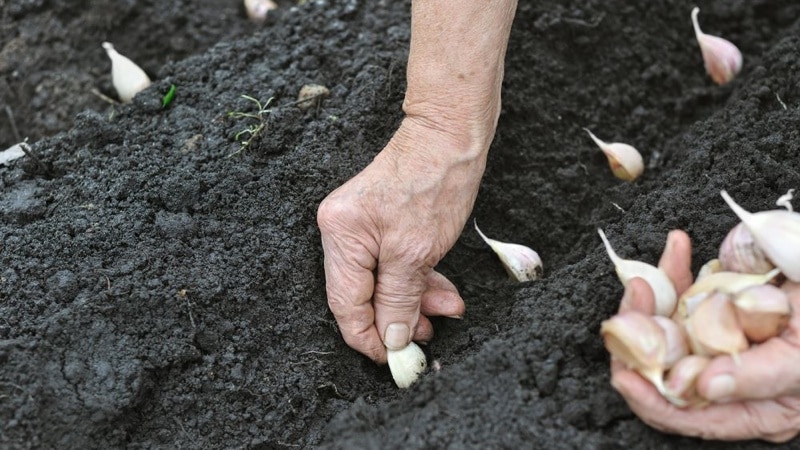
Rules for planting garlic in winter
It is advisable to treat the seed material before planting. Potassium permanganate (0.1% solution) or copper sulfate (1% solution) is suitable for this. The seeds are soaked in it a day before planting.
The cloves can be planted in grooves or holes. To make the grooves even, you can stretch a rope over the pegs and draw along it. There should be a distance of 20-25 cm between the beds, and you need to lay garlic in the furrows or make holes for it at a distance of 10 cm.
Clove depth
At what depth should I plant garlic? The depth of the holes or furrows for planting garlic varies from 5 to 15 cm, depending on climatic conditions. If you have severe frosts, it is better to plant deeper so that the teeth do not freeze. It is undesirable to bury the garlic by pressing it, - this way the root system takes longer and develops worse. After laying the cloves, the grooves or holes are closed.
Following planting, many gardeners use soil mulching technology.This allows you to protect the winter crop from frost, improve the thermal insulation of the soil, and reduce the growth of weeds. Dry leaves, pine needles, peat, and spruce branches are used as mulch. The height of the covering layer should not exceed 10 cm.
Winter crop care
We have looked at the rules for planting garlic, now let’s discuss subtleties of care. A crop planted before winter germinates quite early. As soon as the snow has melted, the protective cover is removed. The soil is loosened, fed and weeded.
Loosening
With this procedure, gardeners “close up moisture.” It must be carried out not at a certain time, but depending on the condition of the soil. If you see that it turns from black to gray, it’s time to loosen. Loosening is also carried out after each heavy rain or watering.
Important! Don't be late with loosening. If a crust of dense soil is allowed to form, it is more difficult to remove. You will need to loosen deeper, and you will damage the tender roots of young garlic.
Fertilizer
In order for the culture to form large heads and the cloves to be tasty, the garlic must be fed. The first feeding is done a week after the snow melts. The second one is in two more weeks. The third is carried out at the beginning of June, when the head is actively forming. The third time you need to avoid nitrogenous fertilizers.
be careful! Late application of fertilizing may have the opposite effect or be wasted. For example, garlic fed at the wrong time can begin to produce abundant greenery, but the heads, on the contrary, will be small.
Types of fertilizers
There are quite a few types of mineral and organic compounds used for fertilizing. Let's talk in more detail about some of them.
- Ammonium nitrate – contains nitrogen (suitable for spring feeding), it is recommended to feed in the spring with an interval of three weeks:
- application – 15 mg of fertilizer per 10 liters of water;
- consumption – 3l/1m².
- Urea – contains nitrogen (suitable for spring feeding):
- application: 1 tbsp. l. fertilizers per 10 liters of water;
- consumption – 3l/1m².
- Nitroammofoska – contains nitrogen, sulfur, potassium, phosphorus:
- use for foliar feeding – 1 tbsp. l. fertilizers per 10 liters of water;
- for root feeding, the dose of fertilizer per 10 liters of water is doubled;
- consumption – 3l/1m².
- Superphosphate, contains phosphorus:
- application – 2 tbsp. l. fertilizers per 10 liters of water;
- consumption – 4l/1m².
Useful organics
- Ash – contains potassium and phosphorus:
- application - scatter it on the beds or prepare an infusion;
- Preparation: 0.5 liters of ash per 10 liters of water, leave for 24 hours, apply at the root.
- Yeast – contain important amino acids:
- Application: pour the solution over garlic;
- preparation - dissolve 200 g of yeast in 1 liter of water, leave for 24 hours, bring to 10 liters.
- Ammonia – contains a lot of nitrogen:
- application - garlic feathers are treated with a solution (it is also used for watering the soil, but before planting);
- Preparation: 25 ml of ammonia per 10 liters of water.
Irrigation scheme
Garlic does not like too much watering, but dry weather does not contribute to its proper growth.. Don’t forget to cover up the moisture after watering.
The plant watering scheme is as follows:
- rainy, cloudy - no need to water;
- hot, dry - watering once every five days;
- moderately hot, with rare precipitation - watering once every 7-10 days.
Do not forget! It is necessary to remove the arrow-inflorescence from shooting garlic even before it blooms, since the plant will devote all its energy to its growth and development, and the head and cloves will be small.
Harvesting and storage
The speed of garlic ripening depends on the variety and climatic conditions. But most often it “fits” into 100 days. The crop is harvested at the end of July or beginning of August. To understand how ripe the spicy cloves are, you need to know a few rules that experienced gardeners use.
The simplest thing is to leave the inflorescences of one or two garlic plants. The arrow has straightened and the inflorescences have opened - the crop is ready for harvesting. Also, ripeness is indicated by drying of all or only the lower leaves and stem.
It's easy to find out if the garlic is ripe by simply digging up a couple of heads. The husk on them should be dry, the slices should be even, elastic, and easily separated.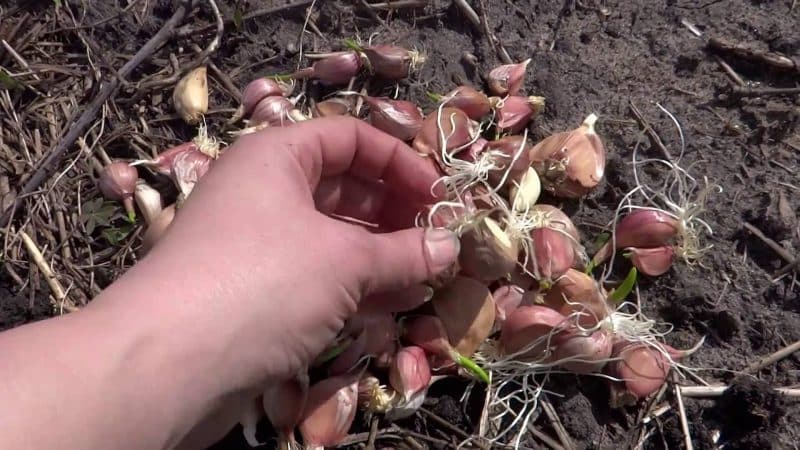
How to save the harvest
It is important not to leave the garlic in the ground too long and not to remove it too early. It is optimal to dig it up a couple of days before it is fully ripe. It will ripen during the drying process. You can’t damage the fruits by pulling them out of the ground—the spicy crop needs to be dug up. It is forbidden to hit soil that has not adhered to garlic, for example, with a shovel; it is better to clean it with your hands. Damaged slices will quickly begin to rot.
Dry garlic in the shade outdoors or in a well-ventilated room. It is useful to dry it together with the leaves, heads down: beneficial substances penetrate from the greenery into the bulb, which qualitatively affects its taste and benefits. For long-term storage, undamaged heads, completely covered with husk, are selected. Onions covered with three layers of husk store best.
Dried garlic is stored in a dark place at t° -2...+ 2 C° and humidity no more than 80%. A cellar or basement would be suitable. The heads are stored in braids, placed in cardboard boxes or plywood boxes. For storage in apartments, garlic is most often placed in jars whole or in slices, preserving the shell.
Place the bulbous plant in a clean, dried container, sprinkling it with your choice of flour, onion peels, expanded vermiculite or ash. Peeled slices are also stored in oil or embedded in paraffin. Regular sterile jars with metal lids will also work. They also use fabric bags soaked in salt. You can freeze or dry the spice.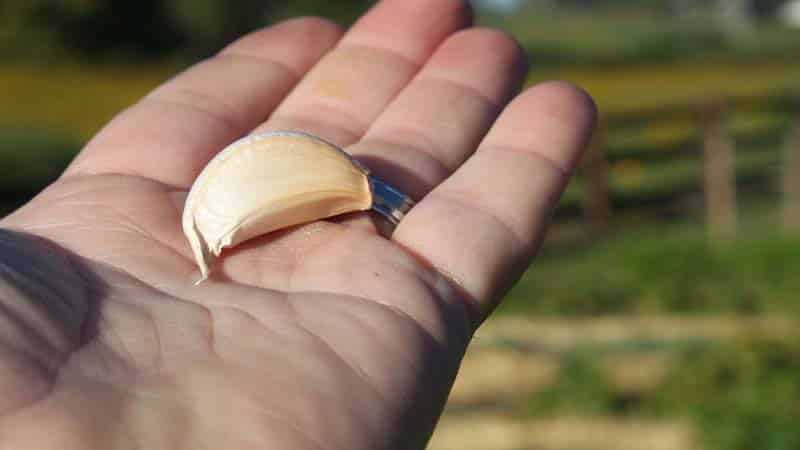
Conclusion
Garlic is a seasoning that has been known for centuries. It is famous for its taste and benefits, and contains many essential vitamins and microelements. It is easy to grow, especially in winter. Winter garlic is larger and tastier than spring garlic. It is enough to give him a little time and attention.
To please you with a bountiful harvest of garlic, follow our advice: consider crop rotation, prepare the soil, water, loosen and feed the sprouted garlic. After cleaning, air dry. And store at a humidity of no more than 80%.